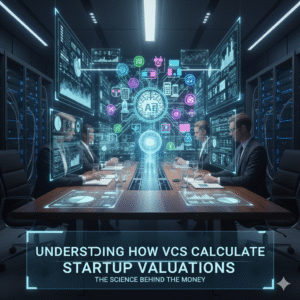A Founder’s Roadmap to Valuation, Equity Dilution, and Return Calculations Using Professional Investment Frameworks
The Valuation Question Most Founders Can’t Answer
Few scenarios make founders more uneasy than facing an investor’s pointed question: “What valuation are you seeking?”
The typical founder lacks a concrete response. Some reference comparable fundraising announcements from peer companies. Others rely on intuition. A handful start high and negotiate downward.
Here’s what most don’t realize: venture capitalists operate from a systematic framework that’s remained consistent for generations, calculating valuations in reverse from anticipated returns. This approach is known as the Venture Capital Method, and without understanding it, founders negotiate at a significant disadvantage.
Founders who grasp the VC Method secure funding more efficiently, sidestep damaging down rounds, and maintain ownership through successive capital raises.
This guide demystifies the Venture Capital Method and provides practical tools to replicate investor calculations.
Defining the Venture Capital Method
The Venture Capital Method represents an investment framework that determines startup values by projecting backward from anticipated exit scenarios.
Rather than attempting to model cash flows (impractical for pre-seed or seed stage companies), it poses a different question: “If this venture achieves an exit worth $X after Y years, and I require a 10x multiple, what price makes sense today?”
The process follows these steps:
Project exit value: For instance, $100M based on comparable transactions or revenue multiples
Establish required returns: Typically 25–40% IRR, or 10x for early-stage investments
Calculate present value: Discounting future exit to current valuation
Determine equity requirements: Based on investment amount and target returns
The mathematics are simple, yet the consequences are profound. This explains why founders with identical annual recurring revenue can receive vastly different term sheets based on return requirements.
The Practical Modeling Tool: Calculating Value, Dilution, and Returns
To make this framework actionable, a comprehensive multi-round Excel model tracks the Venture Capital Method from initial seed funding through Series C and later stages.
Key capabilities:
- Round-specific inputs for pre-money, post-money, and investment amounts
- Exit valuation projections using revenue multiple analysis
- Dilution tracking across sequential funding rounds
- Ownership distribution showing founders, investors, and employee option pools
- IRR and cash-on-cash return calculations for each investor cohort
- Scenario planning (baseline, optimistic, pessimistic cases)
This represents the identical analysis investors conduct to evaluate your valuation proposal. Now founders can perform these calculations before negotiations begin.
Why This Matters for Founders
The most critical founder mistake is evaluating valuation round by round in isolation. “If I secure $20M post-money, that’s success.”
However, capital raising operates as a multi-round sequence. Raising $1M initially and $10M subsequently creates specific ownership implications at exit. Your Series C pricing affects early investor returns.
The Venture Capital Method demands comprehensive perspective across the entire funding lifecycle.
This analytical framework addresses:
- Fair valuation determination: What pre-money makes sense given investor return targets?
- True equity cost: How much ownership am I surrendering across all rounds?
- Exit scenario analysis: What does a $200M exit mean for me, my team, and backers?
- Justification strength: Can I support my valuation with quantitative evidence rather than narrative?
Many founders believe valuation discussions center on storytelling. That belief persists until detailed financial models appear. Then it becomes pure mathematics.
The Strategic Advantage
Understanding the Venture Capital Method transforms founders from passive participants to informed negotiators. When you comprehend how investors calculate required ownership stakes, you can structure rounds that balance capital needs with long-term ownership preservation.
This knowledge also reveals when proposed valuations create unsustainable expectations. A $50M Series A valuation sounds impressive until modeling shows it requires a $500M+ exit just to deliver acceptable returns to your investors. If that outcome seems unrealistic given your market size, accepting that valuation today sets up future challenges.
The framework illuminates trade-offs that aren’t immediately obvious:
- Raising at maximum valuation isn’t always optimal if it creates unrealistic exit pressure
- Small investments at high valuations can complicate future rounds more than larger investments at fair valuations
- Option pool sizing before versus after funding rounds dramatically impacts founder dilution
- Multiple liquidation preferences can mean founders earn nothing even in moderately successful exits
Sophisticated founders use this method not just to understand investor offers, but to proactively model optimal round structures before beginning fundraising conversations.
Running the Numbers
The difference between founders who understand this framework and those who don’t becomes evident during negotiations. When an investor proposes specific terms, founders with modeling capability can immediately assess:
- Whether the implied ownership percentage aligns with stated investment amounts
- If the pre-money valuation supports reasonable Series B pricing in 18-24 months
- How much dilution founders and early employees face across a realistic funding path
- What exit values are required to generate meaningful returns for everyone involved
This isn’t theoretical knowledge. It’s practical negotiating leverage that helps founders secure favorable terms while maintaining investor relationships.
Moving Forward
The Venture Capital Method isn’t just investor jargon—it’s the fundamental framework underlying startup valuation discussions worldwide. Whether you’re preparing for your first angel round or structuring a growth-stage financing, understanding how investors think about returns and ownership will strengthen your position.
The best founders don’t just accept valuations. They understand where those numbers come from, what they imply about future performance expectations, and how they affect long-term ownership and alignment. That understanding separates founders who maintain control of their cap tables from those who wake up after several rounds wondering where their equity went.
Master the method. Run the numbers. Negotiate with confidence.








